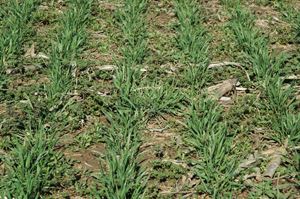Challenges In Weed Management In Wheat Due To Wet Conditions
DR. JAMES R. MARTIN
PRINCETON, KY.
The large amount of snow cover, combined with recent rainfall, has made it a challenge to treat for weeds as we transition into spring. The following are some suggestions to consider as we progress through the next few days:
• Harmony and Harmony Extra are examples of ALS-inhibitor herbicides that can injure wheat under cool, wet soil conditions. Injury may also occur if wide fluctuations of day and nighttime temperatures occur prior to, or soon after, application. It is not clear to what extent, if any, the injury observed with Harmony and Harmony Extra impacts wheat yield. The labels of these products recommend adding 2,4-D as a tank mix partner to limit the risk of injuring wheat from the ALS-inhibitor herbicides. It is important to recognize that the safest time to use 2,4-D in wheat is when plants are fully tillered and prior to jointing.
• Any significant delay in applications due to wet conditions may allow time for wheat to grow beyond the labeled growth stage. Dicamba is especially of concern when applied to wheat that is jointing or is later in growth.
• The delay in applying wheat herbicides this spring increases the demand to use the same sprayer for applying early preplant treatments for corn. Clean sprayers thoroughly before switching to the other crops. If changing from corn to wheat, be aware that small amounts of glyphosate, Valor, or atrazine left in the tank may lead to crop injury when subsequent treatments are applied to wheat. Do not leave spray mixes in the tank or lines overnight.

Figure 1. Weeds in wheat
Photo: James Martin, UK; 3-15-2015
• Controlling ALS-resistant common chickweed that overwintered may be a challenge. Growers will not have the option of using Harmony Extra for managing populations resistant to this chemistry. Starane Ulta, Huskie, and metribuzin have some activity on common chickweed. One concern with metribuzin is the risk of crop injury due to susceptibility of wheat varieties. This may be particularly true when using high rates of metribuzin.
• The delay in applications may force growers to topdress nitrogen fertilizer and spray herbicides close to the same time. Such herbicides as Osprey and PowerFlex have potential to injure wheat when applied near the time of topdressing nitrogen. The PowerFlex label cautions against making applications within 7 days of topdressing ammonium nitrogen fertilizer, while the Osprey label suggests waiting 14 days between application and topdressing. Axial is an alternative to Osprey or PowerFlex in managing Italian ryegrass and avoiding wheat injury when applied near the time of topdressing nitrogen. ∆
DR. JAMES R. MARTIN: Extension Professor of Weed Science, University of Kentucky